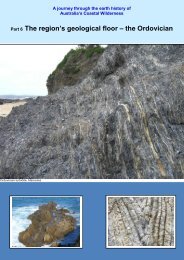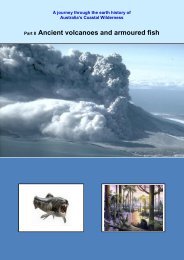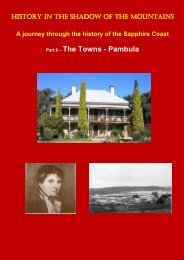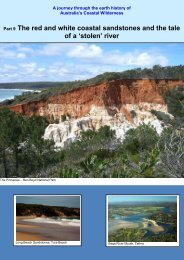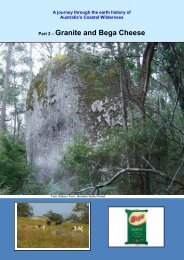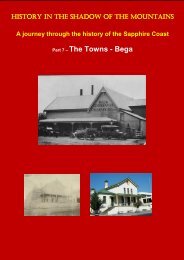Part 9-The Towns â Bermagui & Cobargo - Sapphire Coast
Part 9-The Towns â Bermagui & Cobargo - Sapphire Coast
Part 9-The Towns â Bermagui & Cobargo - Sapphire Coast
- No tags were found...
You also want an ePaper? Increase the reach of your titles
YUMPU automatically turns print PDFs into web optimized ePapers that Google loves.
HISTORY IN THE SHADOW OF THE MOUNTAINSA journey through the history of the <strong>Sapphire</strong> <strong>Coast</strong><strong>Part</strong> 9 – <strong>The</strong> <strong>Towns</strong> – <strong>Bermagui</strong> & <strong>Cobargo</strong>
<strong>Bermagui</strong>(Maps on the last page)<strong>The</strong> name <strong>Bermagui</strong> is thought to derive from ‘Bermaguee’ (boat with no paddle),which in turn was probably derived from ‘permageua’, a word from the vocabulary ofthe local Djiringanj people, with no known meaning. <strong>The</strong> port at <strong>Bermagui</strong> was firstestablished in the 1830s for the local dairy farmers, sawmillers and fishermen. <strong>The</strong>town quickly developed into a fishing harbour.In 1888 a wharf was built at <strong>Bermagui</strong> that serviced vessels until the 1950s. In itsearly days the Illawarra Steam Navigation Company serviced the port. By 1900 adairy industry and a timber mill provided employment for many workers.An article in the Sydney Morning Herald newspaper 4 July 1887, read:<strong>Bermagui</strong> itself is merely a village containing not more than 100 residents. Itboasts of a very fair public-house, dignified by the name of the Royal Hotel,and kept by P. Engstrom, who provides good accommodation to hiscustomers, and a plain but wholesome bill of fare. Two stores appear tomaintain a healthy existence, and the public school has, I believe, an averageattendance of about 30 pupils. <strong>The</strong>re is also a post-office which despatchesand receives mails four times a week, twice via <strong>Cobargo</strong>, and twice via TilbaTilba. <strong>The</strong> great industry at present on the <strong>Bermagui</strong> River or more properlyspeaking, Tidal Creek, is a sawmill which is carried on by Mr T. Moorhead,who appears to carry on an extensive business between <strong>Bermagui</strong> andSydney, as well as intermediate ports. For this purpose he has two vesselsrunning, the Jane Moorhead and the Sarah Beattie, which are his ownproperty, and the Morunna which is chartered by him. <strong>The</strong>se vessels being oflight draught manage to navigate the shallow entrance to the creek withoutmuch difficulty, and when the tide and wind serve, are able to run right up tothe Government wharf, a distance of fully half a mile. <strong>The</strong> landing-place forpassengers by the Illawarra Company’s steamers, which call twice a week, isin a small bay on the other side of the creek, and is perfectly safe exceptperhaps in heavy north-easterly weather. At present passengers areconveyed to the above in the ship’s boat, but in a very short time thesteamers will be able to rest snugly alongside a substantial jetty…One great drawback, however, which threatens to seriously injure the value ofthe jetty for a large number of settlers who may desire to use it, is theabsence of any bridge or punt to connect North with South <strong>Bermagui</strong>. <strong>The</strong>farmers of Dry River, Upper Brogo, and Murrah, which lie to the South of<strong>Bermagui</strong> will be able to enjoy the shipping facilities which the completion ofthe Jetty offers, while the producers of <strong>Cobargo</strong>, Wandello, Tilba Tilba andDignam’s Creek will be shut out from all participation in the benefit unlessthey have some permanent means of crossing the creek. This, I aminformed, could be provided by a comparatively small expenditure. <strong>Bermagui</strong>is the natural port of shipment for a district covering a radius of from 25 to 30miles, the main industry of which is dairy farming. Maize, cheese, and wattlebark are the principal exports, and, the soil being extremely fertile, vegetablegardening is carried on to a considerable extent and with marked success….<strong>Bermagui</strong> is situated in one of the most picturesque portions of the southerncoast, and now that a suitable jetty has been provided, the locality will nodoubt be visited by a large number of persons from the metropolis in search
of rest or recreation when increased accommodation is afforded and theIllawarra Steam Navigation Company become enlightened as to the necessityof reducing their fares to something a little more reasonable. Two pounds fora journey of 160 miles is an enormous charge; and the residents complain notonly of this, but of the heavy freights charged for the conveyance of theirproduce to market. <strong>The</strong>se things, however, may be adjusted by healthycompetition and more energy and enterprise on the part of the residentsthemselves, who so far have taken no steps to secure a remedy of thegrievance under which they labour.<strong>Bermagui</strong> Wharf<strong>The</strong> construction of a bridge over Wallaga Lake in 1894 gave farmers to the northeasy access to the coastal steamer, which travelled from the <strong>Bermagui</strong> wharf toSydney. Many families settled in the area and close links and rivalries developedbetween <strong>Cobargo</strong>, <strong>Bermagui</strong> and Tilba.In 1959 the Public Works Department built a new fishing harbour. <strong>The</strong> most recentupgrade, largely funded by the <strong>Bermagui</strong> Fishermen’s Cooperative, includes acomplex of shops and restaurants facing the harbour and opening up a splendidpanorama across the bay to Gulaga Mountain.<strong>Bermagui</strong> has had some ‘mysterious’ and ‘strange’ visitors. In1880, the same yearNed Kelly was captured in Glenrowan in Victoria, a geologist, Lamont Young, andfour others disappeared while on a boat trip from <strong>Bermagui</strong>. A report of the timerelated:Young was inspecting the new goldfields at <strong>Bermagui</strong> in 1880. In order toinvestigate possible sites further north, Young and his assistant travelled on asmall boat with the boat's owner, Thomas Towers of Bateman’s Bay, and twoof Towers' friends. All five disappeared on 10 October. In the morning theboat was observed, but stationary and with apparently only one man onboard. Later in the day the vessel was seen stranded on the rocks with noone on board. <strong>The</strong> boat was found to contain five bags full of clothing,Young's books and papers, a bullet in its starboard side and some vomit. <strong>The</strong>men were not found despite subsequent searches, rewards, governmentinquiries and wide media coverage. <strong>The</strong> remnants of a fire, some food andthree shirt studs were the only traces. <strong>The</strong> mystery was never solved.Unusual aspects of the wreck were that the planks of the boat were stove-outrather than stove-in, the boat contained several large rocks and the anchorand stern ropes were missing.<strong>The</strong>ir boat was found near a bay about 15 km north of <strong>Bermagui</strong>, just south ofNarooma. This bay is named Mystery Bay, in association with the incident.
Zane GreyZane Grey, a well-known American big-game fisherman of the 1930s and the authorof Westerns, wrote of his experiences in <strong>Bermagui</strong>. He was patron of the <strong>Bermagui</strong>Sport Fishing Association for 1936-37 and anchored his yacht, the Avalon inHorseshoe Bay.Zane GreyGrey helped establish deep-sea sport fishing in NSW, particularly in <strong>Bermagui</strong>, whichis famous for marlin fishing. <strong>The</strong> <strong>Bermagui</strong> caravan park is named after him and thelocal hotel has photographs and memorabilia of his sojourn.
World War 2 wreckOver a number of years, local fishermen kept tangling their nets on something on thesea floor at a depth of 125m. It was not until 4 June 2006 that a team of diversconfirmed the wreck of the BHP iron ore carrier SS Iron Night.<strong>The</strong> carrier was part of a convoy of 10 ships travelling up the east coast on 8February 1943. At approximately 2:30 am off <strong>Bermagui</strong>, the Japanese submarineI-21 fired a torpedo at the naval ships flanking the convoy. <strong>The</strong> torpedo passedunder the bow of the Corvette HMAS <strong>Towns</strong>ville and struck the Iron Knight, sinkingher with the loss of 36 crewmen, including her commander, in less than two minutes.Most of the ship's crew were below decks and were unable to escape as the shipwent down. Only 14 survived, clambering aboard a single lifeboat and were pickedup by the French destroyer Triomphant and HMAS Mildura.On 29 July 2006 relatives and descendants of the ship’s crew came to <strong>Bermagui</strong> fora memorial service.Japanese submarine I-21Japanese midget submarine raised in Sydney Harbour<strong>The</strong> I-21 was the most successful Japanese submarine to operate in Australianwaters, participating in the midget submarine attack on Sydney Harbour on 31 May -1 June 1942. <strong>The</strong> submarine sank 44,000 tons of Allied shipping during twodeployments off the east coast of Australia, including the shelling of Newcastle. Italso participated in the attack on the US fleet at Pearl Harbour. <strong>The</strong> I-21disappeared on active service late in 1943 in the Marshall Islands area.
Montreal Goldfield<strong>The</strong> Montreal Goldfield is 7km north of <strong>Bermagui</strong> on Wallaga Lake Road. Canadianprospector Henry Williams discovered the goldfield in 1880. Similar to the impacts ofgold rushes elsewhere in Australia, it brought an influx of miners and an economicboom to the region. It was an important stimulus for the settlement and growth of<strong>Bermagui</strong> and its port. And, just like other gold rushes, it lasted for a fairly shortperiod of time.<strong>The</strong> importance and interest in the Montreal Goldfields are that they are the mostintact mining site in the region and provide a clear picture of alluvial gold mining inthe 1880s. <strong>The</strong> goldfield is an area of approximately six hectares and is covered withapproximately 100 mineshafts, some three metres apart. When it was being mined itwas cleared of vegetation but the bush has since regrown and covered many of theshafts and relics, but there is still a lot to see.<strong>The</strong>re is a concentration of mineshafts, many in good condition, each with its ownsmall mullock heap and evidence of terracing. Three terraces carried out in the1880s along the north and west sides can still be seen. <strong>The</strong> mineshafts are about30m deep. <strong>The</strong> vertical sides are boarded only around the top, yet have maintainedtheir structure and shape. In the northwest corner of the field you can still see metalcogs and a wheel and an impressed circle made by the horse-driven puddlingmachine. Some old horse gear is still there, and you can see house footings andchimney bases. A mine tunnel leads from the beach under Wallaga Lake Road andinto the main field.<strong>The</strong> Allen family was still prospecting on the beach in the 1930s. <strong>The</strong>y lived at LemonTree in the centre of the field between Wallaga Lake and the sea. Some low stumpsand a few chimney bricks mark the site of their house.<strong>The</strong> area is managed as an historic heritage site. Guided tours by local historiansreveal the mysteries and anecdotes of the times. Unfortunately, there are very fewphotographs. Tours run daily at 2pm, or by appointment. Admission to the site is byguided tour only. Further information can be sought onhttp://www.montrealgoldfield.org.au/Montreal GoldfieldVisitors at a mine entrance
<strong>Cobargo</strong><strong>The</strong> town name, <strong>Cobargo</strong>, is an Aboriginal word meaning ‘grandfather’. In the 1860sthe town was known as Wattle Town because of the abundance of wattle trees in thearea, the bark of which was used for tanning leather. It was also known as <strong>The</strong>Junction because of it is at the junction of the Narira and Bredbatoura creeks. <strong>The</strong>name <strong>Cobargo</strong> prevailed.<strong>The</strong> first European settler in 1829 was William Tarlinton from Braidwood (nearpresent day Canberra), who settled at ‘Bredbatoura’. <strong>The</strong> ‘Bredbatoura’ property isstill in existence just south of the town. Tarlinton Street is named after him.By the 1830s many ‘runs’ had been taken up. In 1840 Alexander Imlay settled on aproperty called ‘<strong>Cobargo</strong>’. <strong>The</strong> story of the Imlay brothers’ enterprises in the region isin <strong>Part</strong>s 4 and 5 of this history series.<strong>Cobargo</strong> became a dairying town in the 1870s, shipping butter in kegs to Sydneyfrom <strong>Bermagui</strong>. In 1901 a butter factory opened beside the creek for water supply. Itburnt down in 1926 and was rebuilt. It finally closed in 1980 because of changes inthe milk industry. <strong>The</strong> old butter factory is on the <strong>Cobargo</strong>-<strong>Bermagui</strong> Road. It is nowprivately owned but can be seen from the road.In the early 1900s the <strong>Cobargo</strong>-<strong>Bermagui</strong> Road was very busy with livestock andturkeys being walked from the farms to the <strong>Bermagui</strong> wharf for shipping to Sydney.Apparently the turkeys had ‘shoes’ fitted so that they did not get sore feet!You can obtain a pamphlet from the Information Centre in the main street, thePrinces Highway, which will guide you on a walk through this historic town and itsheritage buildings.Some of the heritage buildings in the town<strong>The</strong> historic <strong>Cobargo</strong> School of Arts building is a classic hardwood weatherboardstructure built in 1887. Dances and concerts were held in the building and it oncehoused a library and a cinema that played silent movies. <strong>The</strong> building still plays anactive role in the community as a venue for all kinds of social, cultural andeducational activities.<strong>Cobargo</strong> School of Arts building<strong>The</strong> first timber construction post office in the main street was built in 1870. <strong>The</strong> brickbuilding standing today was erected in 1890. <strong>The</strong> use of bricks for building was notcommon at that time and records show that the bricks cost over 1000 pounds. <strong>The</strong>ceilings are pressed metal. <strong>The</strong> building also became a telephone exchange in 1910
when the postmaster was also responsible for telephone line repair work in the area.<strong>The</strong> Post Office was also significant for many local people because, from 1918, thepostmaster's wife, Mrs Merrion, maintained a maternity home in the residence.<strong>Cobargo</strong> Post Office<strong>The</strong> delightful Old <strong>Cobargo</strong> Convent on the Wandella Road is a remarkably wellpreserved,post-Federation building with a wide veranda, central hallway andbeautiful pressed metal ceilings in all rooms. It also has a rose garden. It is nowprivately owned and managed as Bed and Breakfast accommodation. It was built in1917 for Josephite nuns, who ran the adjacent school as well as a boarding home forpupils. In 1969 the convent and school were sold to the Dominican Fathers. Itultimately passed into private ownership.Old <strong>Cobargo</strong> Convent<strong>The</strong> first building on your left as you turn into the <strong>Cobargo</strong>-<strong>Bermagui</strong> Road was theAustralian Joint Stock Bank and manager's residence. <strong>The</strong> building, constructed oflocal hardwood, was commenced in 1884 and the bank opened in 1887. <strong>The</strong> bankoperated until 1893 when it was bankrupted as a consequence of the 1890sdepression. <strong>The</strong> premises became the first office of the <strong>Cobargo</strong> Co-Op CreameryButter. In 1918 it became a private residence and haberdashery shop.
Former Australian Joint Stock Bank<strong>The</strong> building which today houses the <strong>Cobargo</strong> Newsagency and General Store in themain street was constructed in 1892. It is a delightful building with its hardwoodframing and verandah over the footpath.<strong>Cobargo</strong> newsagency<strong>The</strong> cemetery on the main road north (Princes Highway) was dedicated in 1876. Awalk through the cemetery will reveal many names of settler families in <strong>Cobargo</strong>.One grave, unfortunately not marked, is that of Bridget Taylor, former wife ofbushranger Ben Hall. She left Ben Hall in 1862 for policeman James Taylor and theylived in <strong>Cobargo</strong> for many years. Some believe this may be the reason that Benbecame a bushranger. Bridget died in 1923 aged 85 and was buried in the Catholicportion of the cemetery.Ben HallBridget Taylor (Hall)
Today <strong>Cobargo</strong> village is a vibrant rural community that provides an interestingdestination for visitors interested in rural heritage. <strong>The</strong> restored and well maintainedoriginal buildings house some of the local artists and craftspeople selling a range oflocally made goods such as woodcrafts, pottery, leather, jewellery and art works.<strong>The</strong>y can often be seen at their crafts working in the way that people did when<strong>Cobargo</strong> was a young town.Tilba Tilba and Central TilbaAbout 20 km north of <strong>Bermagui</strong> and <strong>Cobargo</strong> is the National Trust listed town ofCentral Tilba and the small settlement and cluster of shops at Tilba Tilba. <strong>The</strong> villageof Central Tilba was found in 1895 when Sam Bate subdivided his land. Many ofTilba Tilba’s buildings were constructed in the late 1880s during the gold miningboom. When the mining ceased, dairy farming became the mainstay of the localeconomy. Dairy farming is still important today and ‘boutique’ cheeses are madelocally and sold in Central Tilba and other towns in the region. <strong>The</strong>re is also asaddlery in Central Tilba where leathergoods are made on site. You can check outthe heritage of the town on:www.tilba.com.au
<strong>Bermagui</strong> (Google Earth)
<strong>Cobargo</strong> (Google Earth)




